Managing Information System Proposal for NAB: 2018 Analysis
VerifiedAdded on 2020/05/28
|19
|4189
|304
Report
AI Summary
This report presents a research proposal for implementing a new Management Information System (MIS) at National Australia Bank (NAB). The proposal outlines the current information system at NAB, which includes a Customer Relationship Management (CRM) system, and details the steps of the System Development Life Cycle (SDLC). The report emphasizes the features and benefits of MIS, such as data collection, reporting, and decision support, and how it can improve NAB's operations and customer service. It also discusses the development, testing, and implementation of MIS, as well as potential problems that may arise during implementation. The study highlights how the proposed system aligns with NAB's strategic goals and provides recommendations for the project's approval. The report aims to improve the existing manual information system and increase overall productivity within the bank.
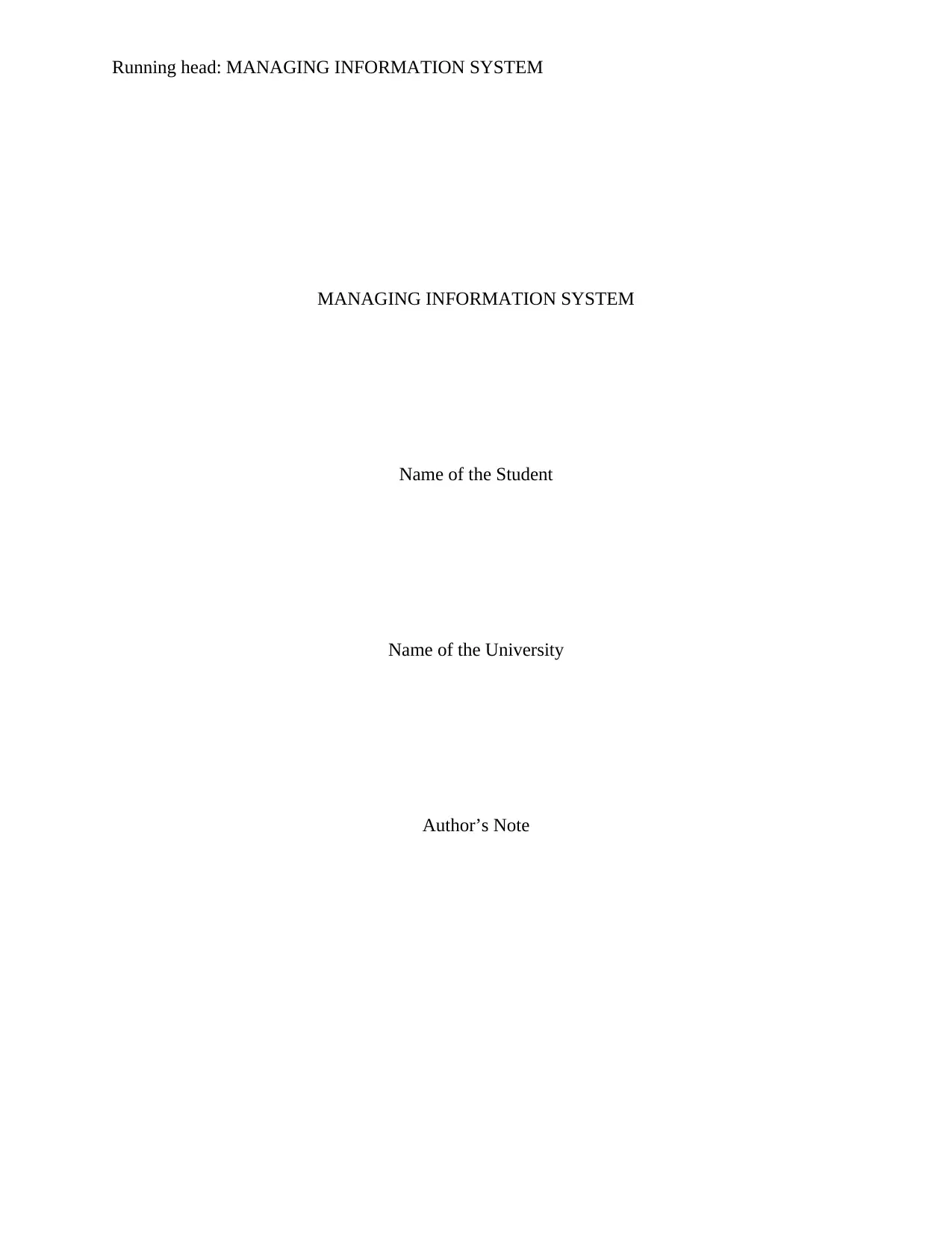
Running head: MANAGING INFORMATION SYSTEM
MANAGING INFORMATION SYSTEM
Name of the Student
Name of the University
Author’s Note
MANAGING INFORMATION SYSTEM
Name of the Student
Name of the University
Author’s Note
Paraphrase This Document
Need a fresh take? Get an instant paraphrase of this document with our AI Paraphraser
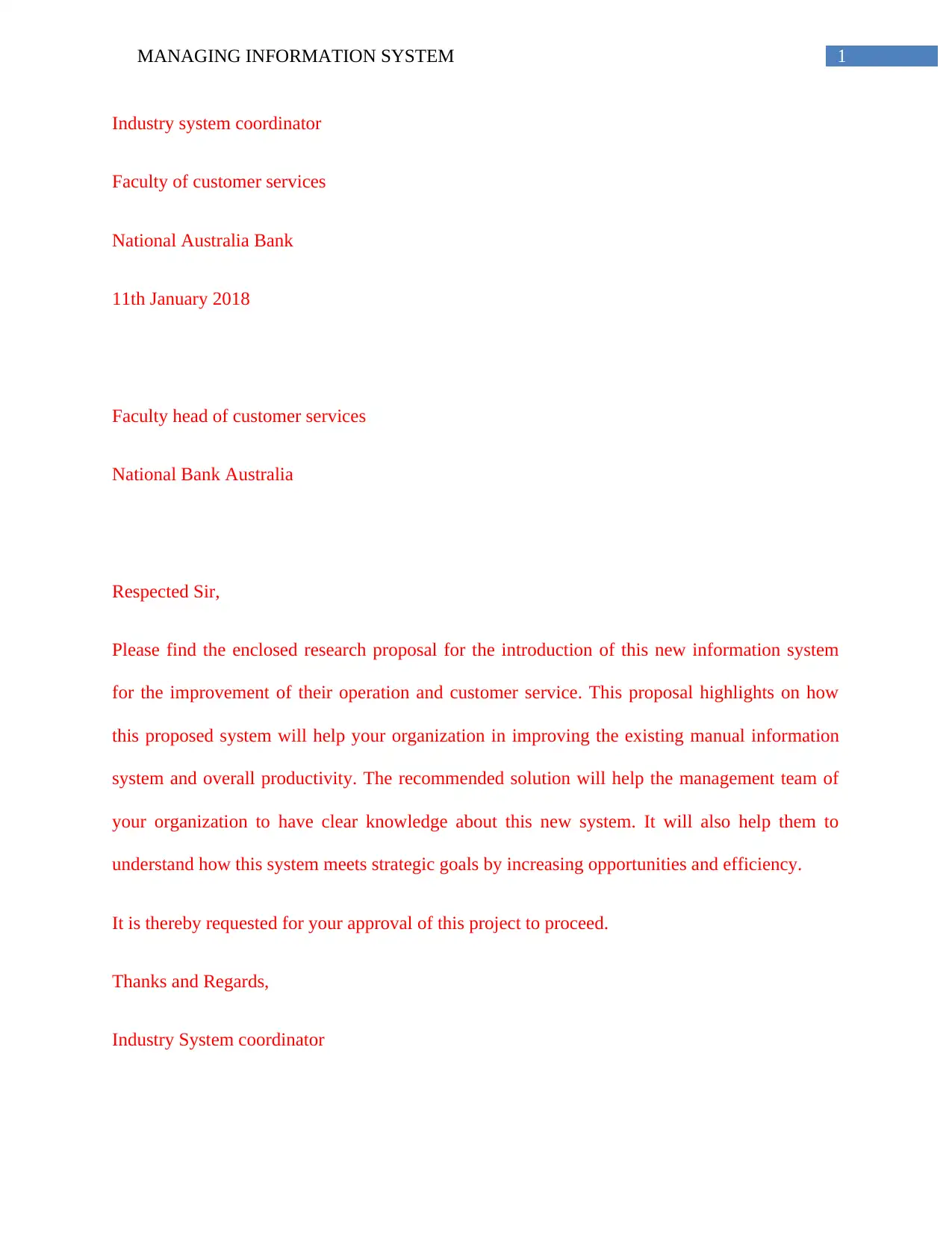
1MANAGING INFORMATION SYSTEM
Industry system coordinator
Faculty of customer services
National Australia Bank
11th January 2018
Faculty head of customer services
National Bank Australia
Respected Sir,
Please find the enclosed research proposal for the introduction of this new information system
for the improvement of their operation and customer service. This proposal highlights on how
this proposed system will help your organization in improving the existing manual information
system and overall productivity. The recommended solution will help the management team of
your organization to have clear knowledge about this new system. It will also help them to
understand how this system meets strategic goals by increasing opportunities and efficiency.
It is thereby requested for your approval of this project to proceed.
Thanks and Regards,
Industry System coordinator
Industry system coordinator
Faculty of customer services
National Australia Bank
11th January 2018
Faculty head of customer services
National Bank Australia
Respected Sir,
Please find the enclosed research proposal for the introduction of this new information system
for the improvement of their operation and customer service. This proposal highlights on how
this proposed system will help your organization in improving the existing manual information
system and overall productivity. The recommended solution will help the management team of
your organization to have clear knowledge about this new system. It will also help them to
understand how this system meets strategic goals by increasing opportunities and efficiency.
It is thereby requested for your approval of this project to proceed.
Thanks and Regards,
Industry System coordinator
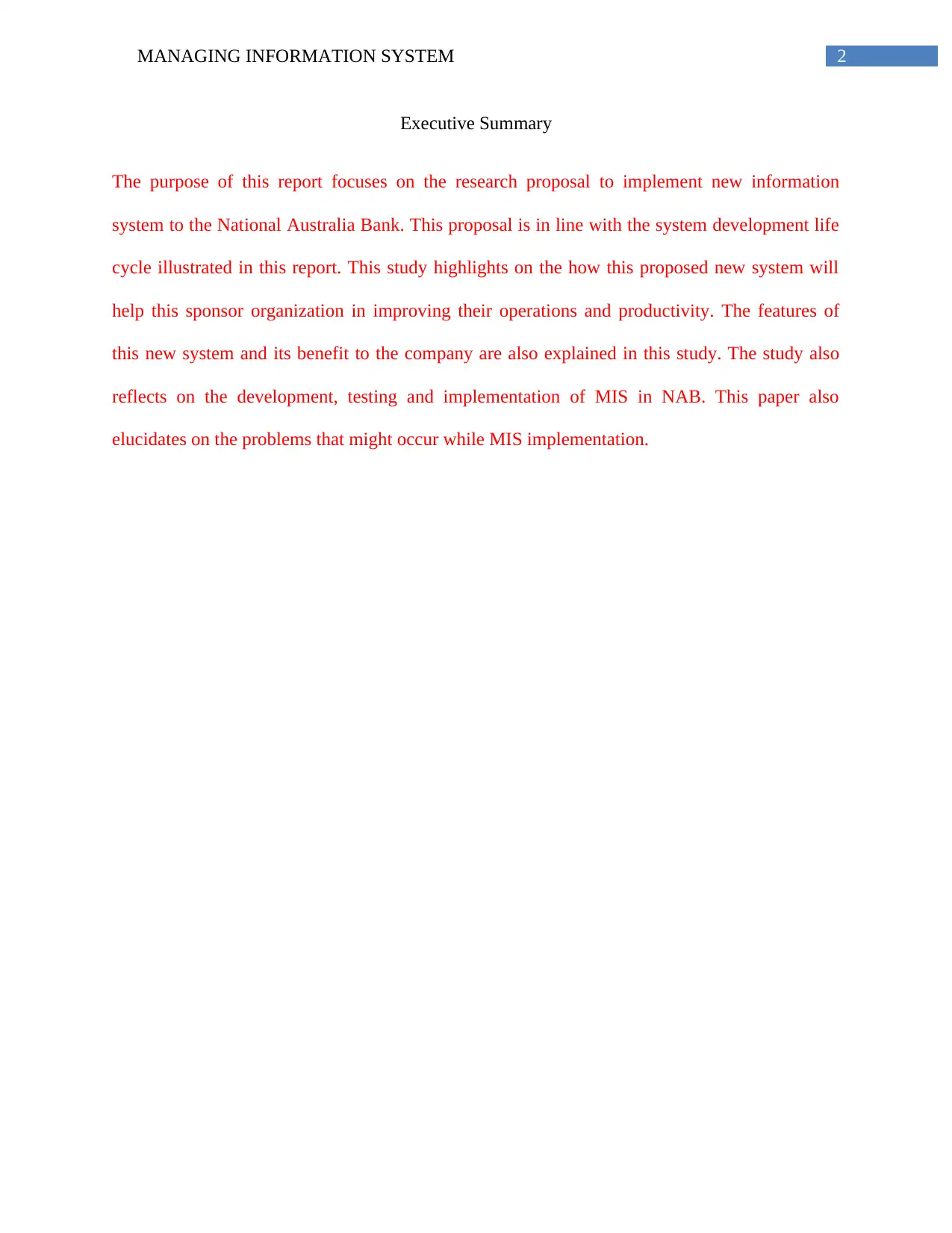
2MANAGING INFORMATION SYSTEM
Executive Summary
The purpose of this report focuses on the research proposal to implement new information
system to the National Australia Bank. This proposal is in line with the system development life
cycle illustrated in this report. This study highlights on the how this proposed new system will
help this sponsor organization in improving their operations and productivity. The features of
this new system and its benefit to the company are also explained in this study. The study also
reflects on the development, testing and implementation of MIS in NAB. This paper also
elucidates on the problems that might occur while MIS implementation.
Executive Summary
The purpose of this report focuses on the research proposal to implement new information
system to the National Australia Bank. This proposal is in line with the system development life
cycle illustrated in this report. This study highlights on the how this proposed new system will
help this sponsor organization in improving their operations and productivity. The features of
this new system and its benefit to the company are also explained in this study. The study also
reflects on the development, testing and implementation of MIS in NAB. This paper also
elucidates on the problems that might occur while MIS implementation.
⊘ This is a preview!⊘
Do you want full access?
Subscribe today to unlock all pages.

Trusted by 1+ million students worldwide
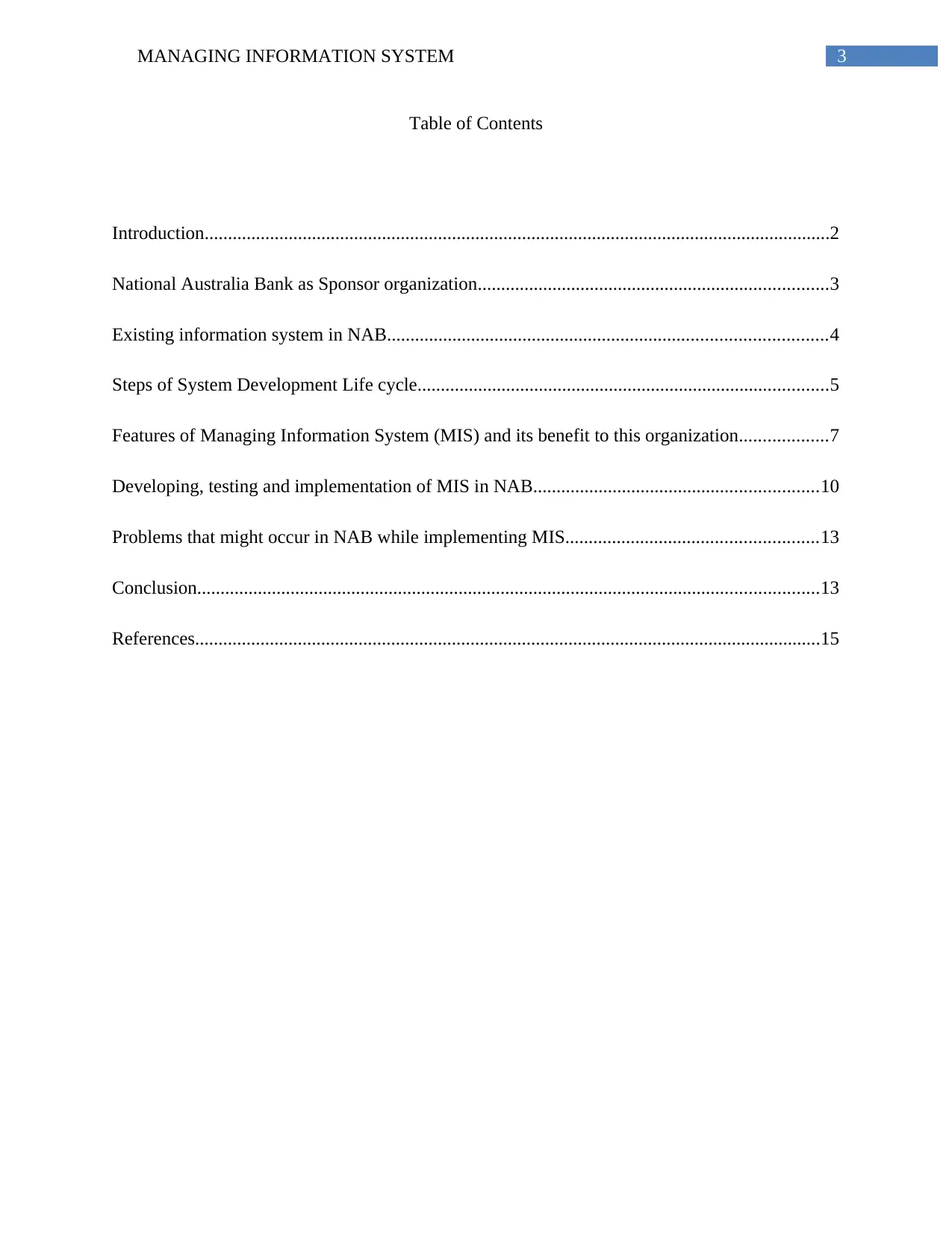
3MANAGING INFORMATION SYSTEM
Table of Contents
Introduction......................................................................................................................................2
National Australia Bank as Sponsor organization...........................................................................3
Existing information system in NAB..............................................................................................4
Steps of System Development Life cycle........................................................................................5
Features of Managing Information System (MIS) and its benefit to this organization...................7
Developing, testing and implementation of MIS in NAB.............................................................10
Problems that might occur in NAB while implementing MIS......................................................13
Conclusion.....................................................................................................................................13
References......................................................................................................................................15
Table of Contents
Introduction......................................................................................................................................2
National Australia Bank as Sponsor organization...........................................................................3
Existing information system in NAB..............................................................................................4
Steps of System Development Life cycle........................................................................................5
Features of Managing Information System (MIS) and its benefit to this organization...................7
Developing, testing and implementation of MIS in NAB.............................................................10
Problems that might occur in NAB while implementing MIS......................................................13
Conclusion.....................................................................................................................................13
References......................................................................................................................................15
Paraphrase This Document
Need a fresh take? Get an instant paraphrase of this document with our AI Paraphraser
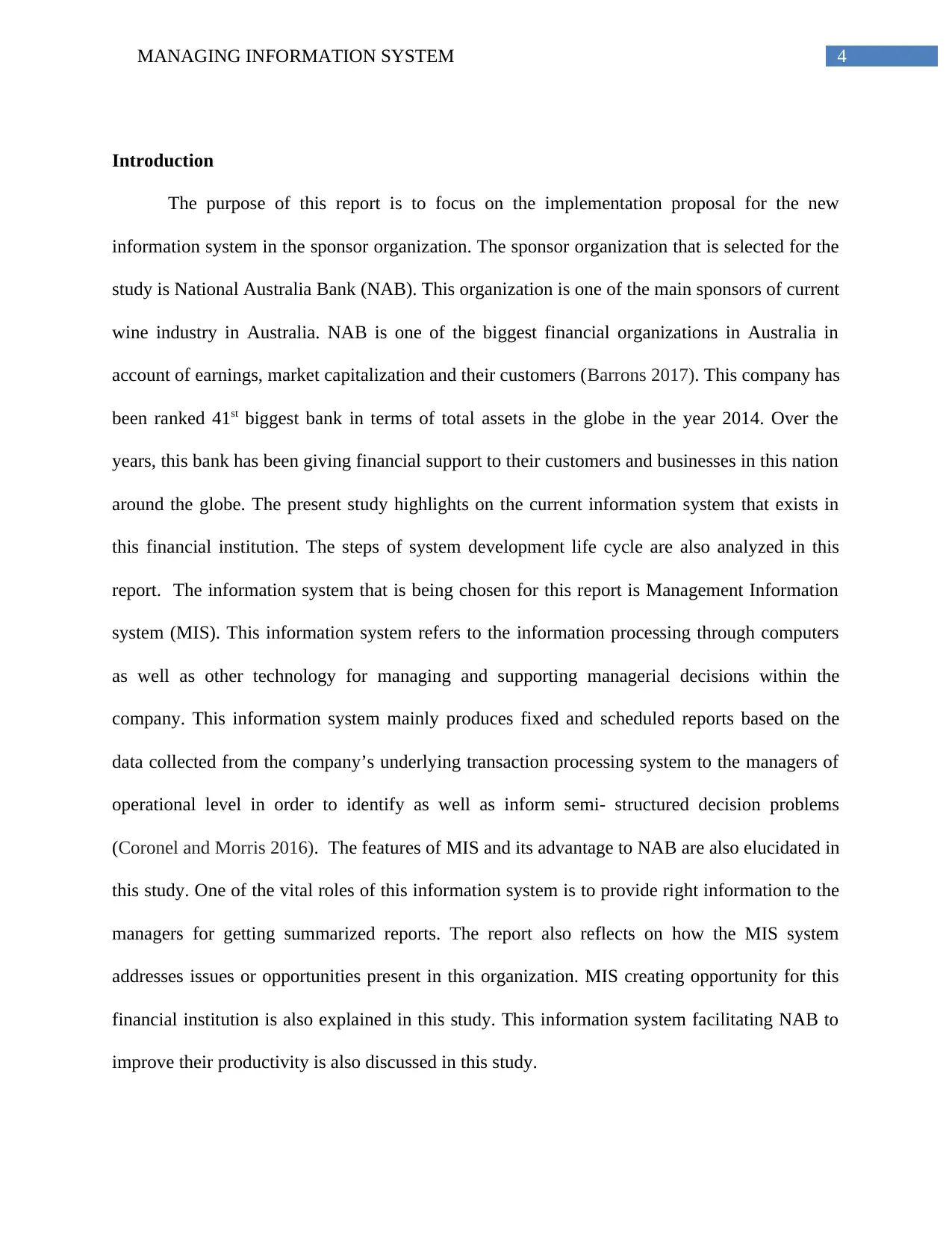
4MANAGING INFORMATION SYSTEM
Introduction
The purpose of this report is to focus on the implementation proposal for the new
information system in the sponsor organization. The sponsor organization that is selected for the
study is National Australia Bank (NAB). This organization is one of the main sponsors of current
wine industry in Australia. NAB is one of the biggest financial organizations in Australia in
account of earnings, market capitalization and their customers (Barrons 2017). This company has
been ranked 41st biggest bank in terms of total assets in the globe in the year 2014. Over the
years, this bank has been giving financial support to their customers and businesses in this nation
around the globe. The present study highlights on the current information system that exists in
this financial institution. The steps of system development life cycle are also analyzed in this
report. The information system that is being chosen for this report is Management Information
system (MIS). This information system refers to the information processing through computers
as well as other technology for managing and supporting managerial decisions within the
company. This information system mainly produces fixed and scheduled reports based on the
data collected from the company’s underlying transaction processing system to the managers of
operational level in order to identify as well as inform semi- structured decision problems
(Coronel and Morris 2016). The features of MIS and its advantage to NAB are also elucidated in
this study. One of the vital roles of this information system is to provide right information to the
managers for getting summarized reports. The report also reflects on how the MIS system
addresses issues or opportunities present in this organization. MIS creating opportunity for this
financial institution is also explained in this study. This information system facilitating NAB to
improve their productivity is also discussed in this study.
Introduction
The purpose of this report is to focus on the implementation proposal for the new
information system in the sponsor organization. The sponsor organization that is selected for the
study is National Australia Bank (NAB). This organization is one of the main sponsors of current
wine industry in Australia. NAB is one of the biggest financial organizations in Australia in
account of earnings, market capitalization and their customers (Barrons 2017). This company has
been ranked 41st biggest bank in terms of total assets in the globe in the year 2014. Over the
years, this bank has been giving financial support to their customers and businesses in this nation
around the globe. The present study highlights on the current information system that exists in
this financial institution. The steps of system development life cycle are also analyzed in this
report. The information system that is being chosen for this report is Management Information
system (MIS). This information system refers to the information processing through computers
as well as other technology for managing and supporting managerial decisions within the
company. This information system mainly produces fixed and scheduled reports based on the
data collected from the company’s underlying transaction processing system to the managers of
operational level in order to identify as well as inform semi- structured decision problems
(Coronel and Morris 2016). The features of MIS and its advantage to NAB are also elucidated in
this study. One of the vital roles of this information system is to provide right information to the
managers for getting summarized reports. The report also reflects on how the MIS system
addresses issues or opportunities present in this organization. MIS creating opportunity for this
financial institution is also explained in this study. This information system facilitating NAB to
improve their productivity is also discussed in this study.
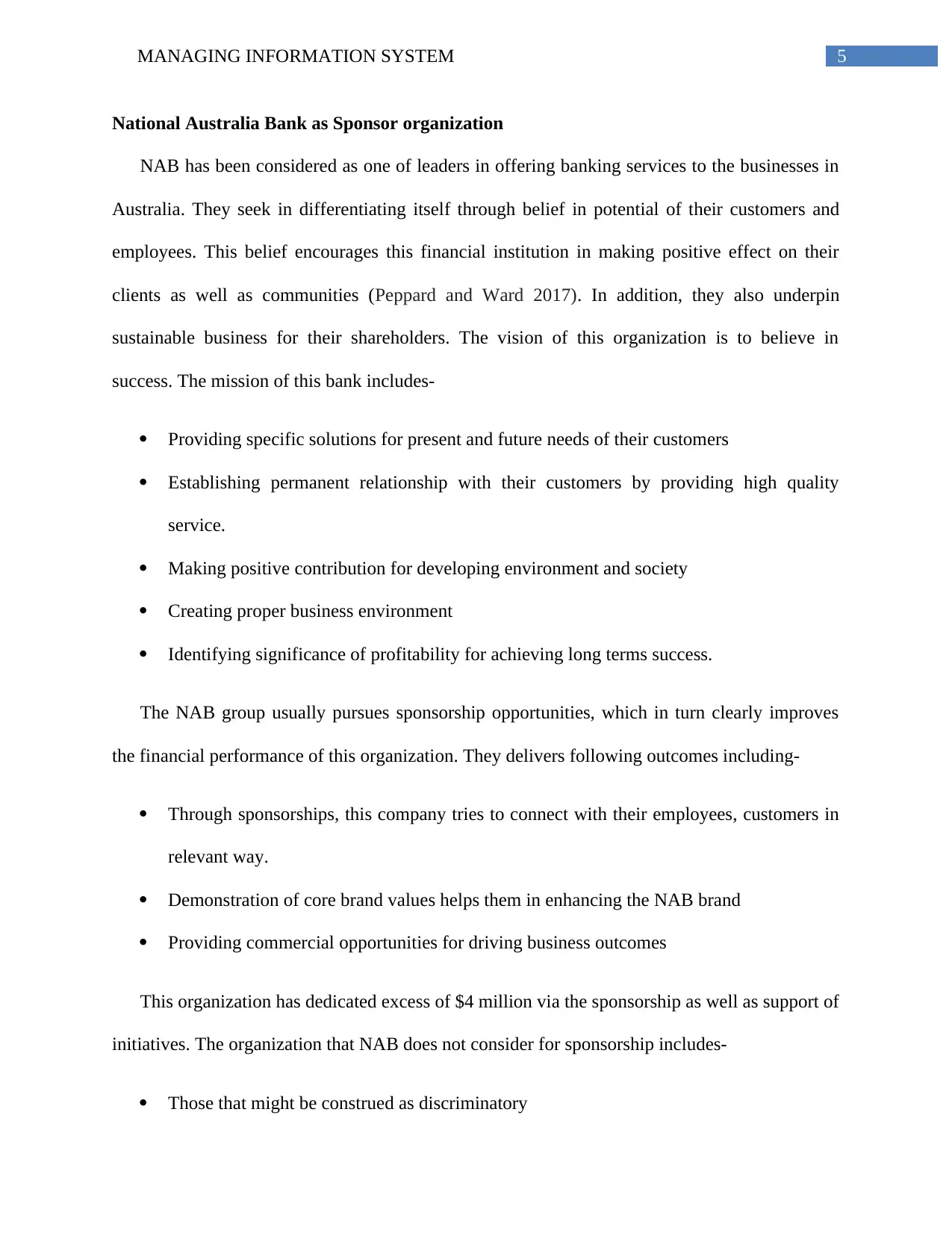
5MANAGING INFORMATION SYSTEM
National Australia Bank as Sponsor organization
NAB has been considered as one of leaders in offering banking services to the businesses in
Australia. They seek in differentiating itself through belief in potential of their customers and
employees. This belief encourages this financial institution in making positive effect on their
clients as well as communities (Peppard and Ward 2017). In addition, they also underpin
sustainable business for their shareholders. The vision of this organization is to believe in
success. The mission of this bank includes-
Providing specific solutions for present and future needs of their customers
Establishing permanent relationship with their customers by providing high quality
service.
Making positive contribution for developing environment and society
Creating proper business environment
Identifying significance of profitability for achieving long terms success.
The NAB group usually pursues sponsorship opportunities, which in turn clearly improves
the financial performance of this organization. They delivers following outcomes including-
Through sponsorships, this company tries to connect with their employees, customers in
relevant way.
Demonstration of core brand values helps them in enhancing the NAB brand
Providing commercial opportunities for driving business outcomes
This organization has dedicated excess of $4 million via the sponsorship as well as support of
initiatives. The organization that NAB does not consider for sponsorship includes-
Those that might be construed as discriminatory
National Australia Bank as Sponsor organization
NAB has been considered as one of leaders in offering banking services to the businesses in
Australia. They seek in differentiating itself through belief in potential of their customers and
employees. This belief encourages this financial institution in making positive effect on their
clients as well as communities (Peppard and Ward 2017). In addition, they also underpin
sustainable business for their shareholders. The vision of this organization is to believe in
success. The mission of this bank includes-
Providing specific solutions for present and future needs of their customers
Establishing permanent relationship with their customers by providing high quality
service.
Making positive contribution for developing environment and society
Creating proper business environment
Identifying significance of profitability for achieving long terms success.
The NAB group usually pursues sponsorship opportunities, which in turn clearly improves
the financial performance of this organization. They delivers following outcomes including-
Through sponsorships, this company tries to connect with their employees, customers in
relevant way.
Demonstration of core brand values helps them in enhancing the NAB brand
Providing commercial opportunities for driving business outcomes
This organization has dedicated excess of $4 million via the sponsorship as well as support of
initiatives. The organization that NAB does not consider for sponsorship includes-
Those that might be construed as discriminatory
⊘ This is a preview!⊘
Do you want full access?
Subscribe today to unlock all pages.

Trusted by 1+ million students worldwide
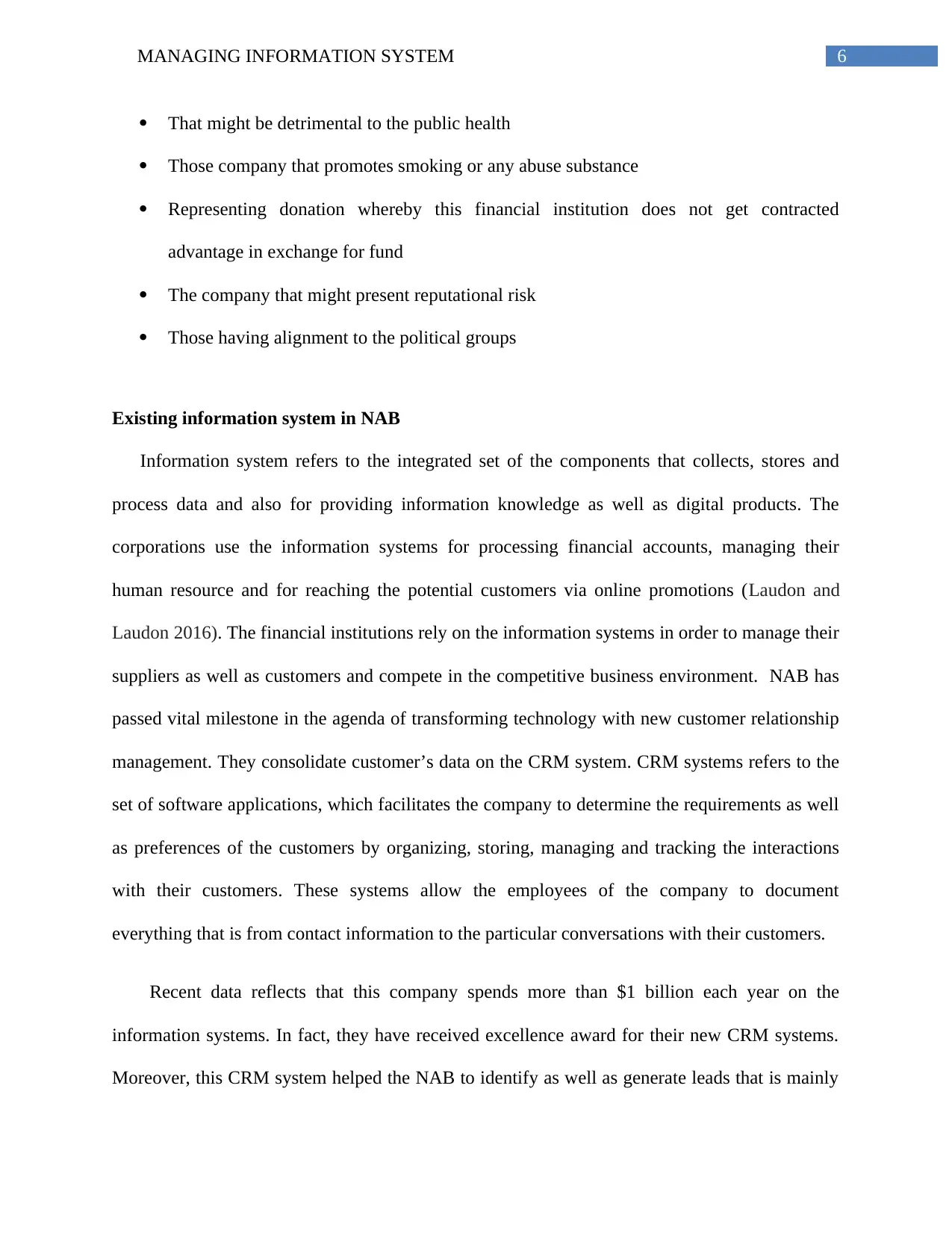
6MANAGING INFORMATION SYSTEM
That might be detrimental to the public health
Those company that promotes smoking or any abuse substance
Representing donation whereby this financial institution does not get contracted
advantage in exchange for fund
The company that might present reputational risk
Those having alignment to the political groups
Existing information system in NAB
Information system refers to the integrated set of the components that collects, stores and
process data and also for providing information knowledge as well as digital products. The
corporations use the information systems for processing financial accounts, managing their
human resource and for reaching the potential customers via online promotions (Laudon and
Laudon 2016). The financial institutions rely on the information systems in order to manage their
suppliers as well as customers and compete in the competitive business environment. NAB has
passed vital milestone in the agenda of transforming technology with new customer relationship
management. They consolidate customer’s data on the CRM system. CRM systems refers to the
set of software applications, which facilitates the company to determine the requirements as well
as preferences of the customers by organizing, storing, managing and tracking the interactions
with their customers. These systems allow the employees of the company to document
everything that is from contact information to the particular conversations with their customers.
Recent data reflects that this company spends more than $1 billion each year on the
information systems. In fact, they have received excellence award for their new CRM systems.
Moreover, this CRM system helped the NAB to identify as well as generate leads that is mainly
That might be detrimental to the public health
Those company that promotes smoking or any abuse substance
Representing donation whereby this financial institution does not get contracted
advantage in exchange for fund
The company that might present reputational risk
Those having alignment to the political groups
Existing information system in NAB
Information system refers to the integrated set of the components that collects, stores and
process data and also for providing information knowledge as well as digital products. The
corporations use the information systems for processing financial accounts, managing their
human resource and for reaching the potential customers via online promotions (Laudon and
Laudon 2016). The financial institutions rely on the information systems in order to manage their
suppliers as well as customers and compete in the competitive business environment. NAB has
passed vital milestone in the agenda of transforming technology with new customer relationship
management. They consolidate customer’s data on the CRM system. CRM systems refers to the
set of software applications, which facilitates the company to determine the requirements as well
as preferences of the customers by organizing, storing, managing and tracking the interactions
with their customers. These systems allow the employees of the company to document
everything that is from contact information to the particular conversations with their customers.
Recent data reflects that this company spends more than $1 billion each year on the
information systems. In fact, they have received excellence award for their new CRM systems.
Moreover, this CRM system helped the NAB to identify as well as generate leads that is mainly
Paraphrase This Document
Need a fresh take? Get an instant paraphrase of this document with our AI Paraphraser
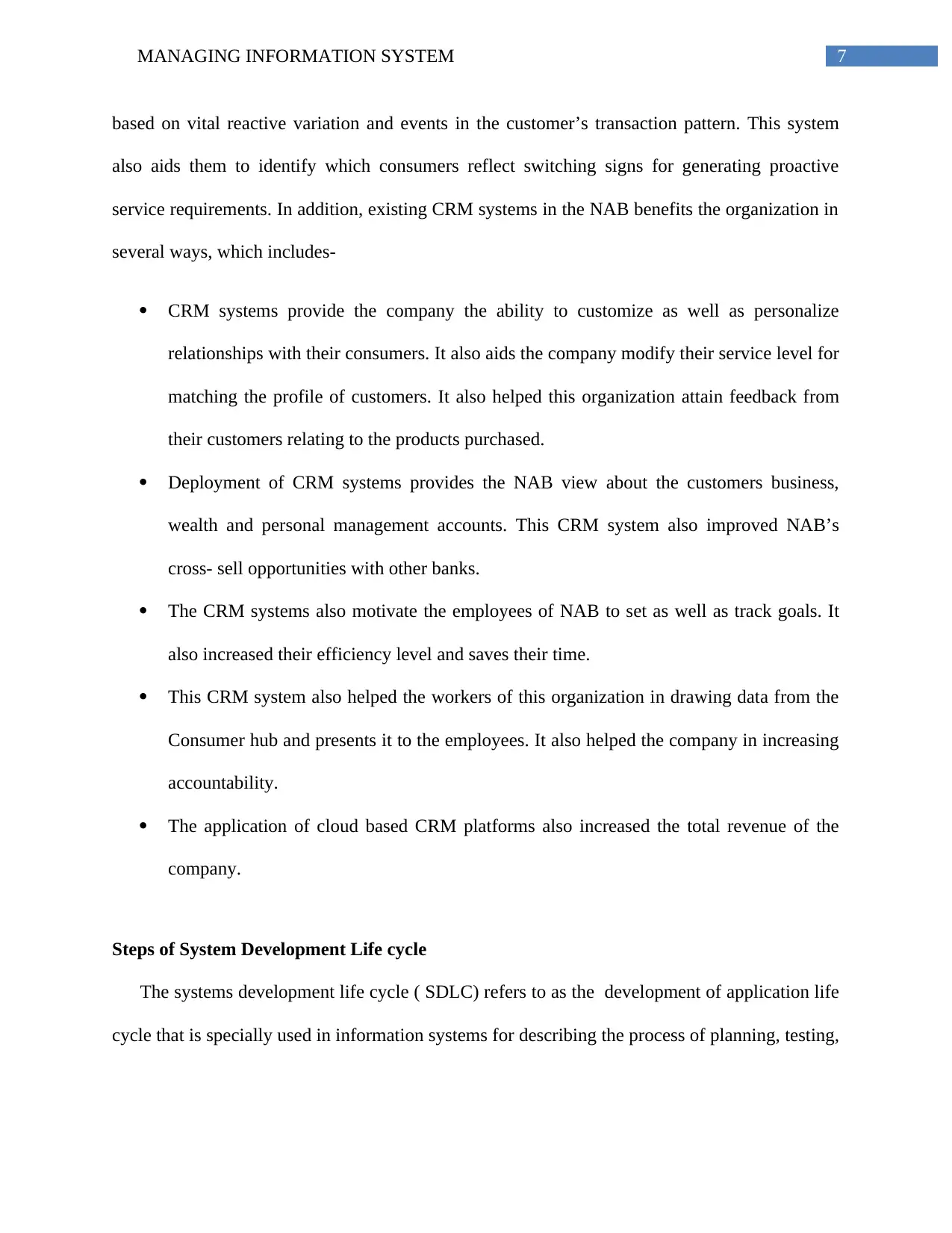
7MANAGING INFORMATION SYSTEM
based on vital reactive variation and events in the customer’s transaction pattern. This system
also aids them to identify which consumers reflect switching signs for generating proactive
service requirements. In addition, existing CRM systems in the NAB benefits the organization in
several ways, which includes-
CRM systems provide the company the ability to customize as well as personalize
relationships with their consumers. It also aids the company modify their service level for
matching the profile of customers. It also helped this organization attain feedback from
their customers relating to the products purchased.
Deployment of CRM systems provides the NAB view about the customers business,
wealth and personal management accounts. This CRM system also improved NAB’s
cross- sell opportunities with other banks.
The CRM systems also motivate the employees of NAB to set as well as track goals. It
also increased their efficiency level and saves their time.
This CRM system also helped the workers of this organization in drawing data from the
Consumer hub and presents it to the employees. It also helped the company in increasing
accountability.
The application of cloud based CRM platforms also increased the total revenue of the
company.
Steps of System Development Life cycle
The systems development life cycle ( SDLC) refers to as the development of application life
cycle that is specially used in information systems for describing the process of planning, testing,
based on vital reactive variation and events in the customer’s transaction pattern. This system
also aids them to identify which consumers reflect switching signs for generating proactive
service requirements. In addition, existing CRM systems in the NAB benefits the organization in
several ways, which includes-
CRM systems provide the company the ability to customize as well as personalize
relationships with their consumers. It also aids the company modify their service level for
matching the profile of customers. It also helped this organization attain feedback from
their customers relating to the products purchased.
Deployment of CRM systems provides the NAB view about the customers business,
wealth and personal management accounts. This CRM system also improved NAB’s
cross- sell opportunities with other banks.
The CRM systems also motivate the employees of NAB to set as well as track goals. It
also increased their efficiency level and saves their time.
This CRM system also helped the workers of this organization in drawing data from the
Consumer hub and presents it to the employees. It also helped the company in increasing
accountability.
The application of cloud based CRM platforms also increased the total revenue of the
company.
Steps of System Development Life cycle
The systems development life cycle ( SDLC) refers to as the development of application life
cycle that is specially used in information systems for describing the process of planning, testing,
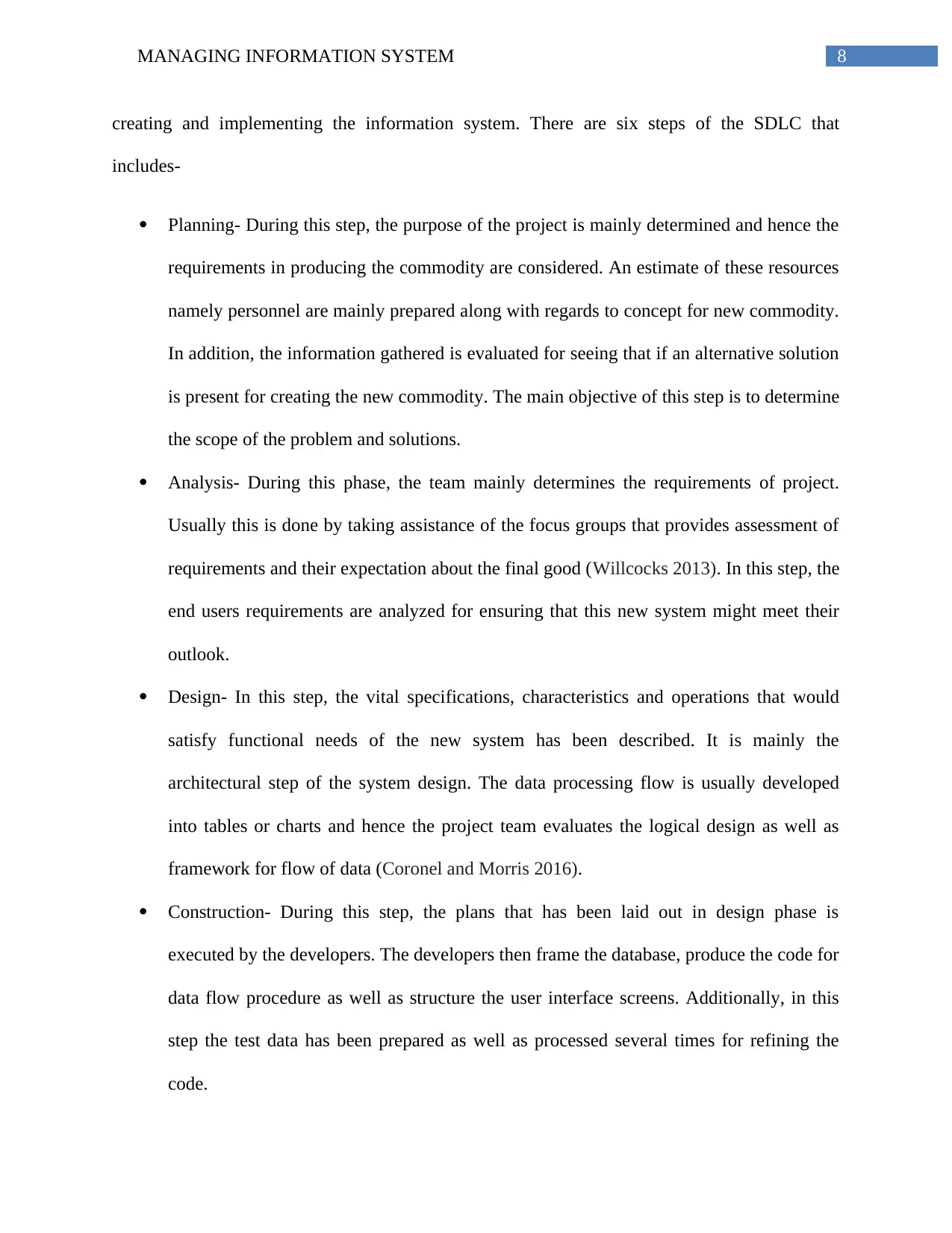
8MANAGING INFORMATION SYSTEM
creating and implementing the information system. There are six steps of the SDLC that
includes-
Planning- During this step, the purpose of the project is mainly determined and hence the
requirements in producing the commodity are considered. An estimate of these resources
namely personnel are mainly prepared along with regards to concept for new commodity.
In addition, the information gathered is evaluated for seeing that if an alternative solution
is present for creating the new commodity. The main objective of this step is to determine
the scope of the problem and solutions.
Analysis- During this phase, the team mainly determines the requirements of project.
Usually this is done by taking assistance of the focus groups that provides assessment of
requirements and their expectation about the final good (Willcocks 2013). In this step, the
end users requirements are analyzed for ensuring that this new system might meet their
outlook.
Design- In this step, the vital specifications, characteristics and operations that would
satisfy functional needs of the new system has been described. It is mainly the
architectural step of the system design. The data processing flow is usually developed
into tables or charts and hence the project team evaluates the logical design as well as
framework for flow of data (Coronel and Morris 2016).
Construction- During this step, the plans that has been laid out in design phase is
executed by the developers. The developers then frame the database, produce the code for
data flow procedure as well as structure the user interface screens. Additionally, in this
step the test data has been prepared as well as processed several times for refining the
code.
creating and implementing the information system. There are six steps of the SDLC that
includes-
Planning- During this step, the purpose of the project is mainly determined and hence the
requirements in producing the commodity are considered. An estimate of these resources
namely personnel are mainly prepared along with regards to concept for new commodity.
In addition, the information gathered is evaluated for seeing that if an alternative solution
is present for creating the new commodity. The main objective of this step is to determine
the scope of the problem and solutions.
Analysis- During this phase, the team mainly determines the requirements of project.
Usually this is done by taking assistance of the focus groups that provides assessment of
requirements and their expectation about the final good (Willcocks 2013). In this step, the
end users requirements are analyzed for ensuring that this new system might meet their
outlook.
Design- In this step, the vital specifications, characteristics and operations that would
satisfy functional needs of the new system has been described. It is mainly the
architectural step of the system design. The data processing flow is usually developed
into tables or charts and hence the project team evaluates the logical design as well as
framework for flow of data (Coronel and Morris 2016).
Construction- During this step, the plans that has been laid out in design phase is
executed by the developers. The developers then frame the database, produce the code for
data flow procedure as well as structure the user interface screens. Additionally, in this
step the test data has been prepared as well as processed several times for refining the
code.
⊘ This is a preview!⊘
Do you want full access?
Subscribe today to unlock all pages.

Trusted by 1+ million students worldwide
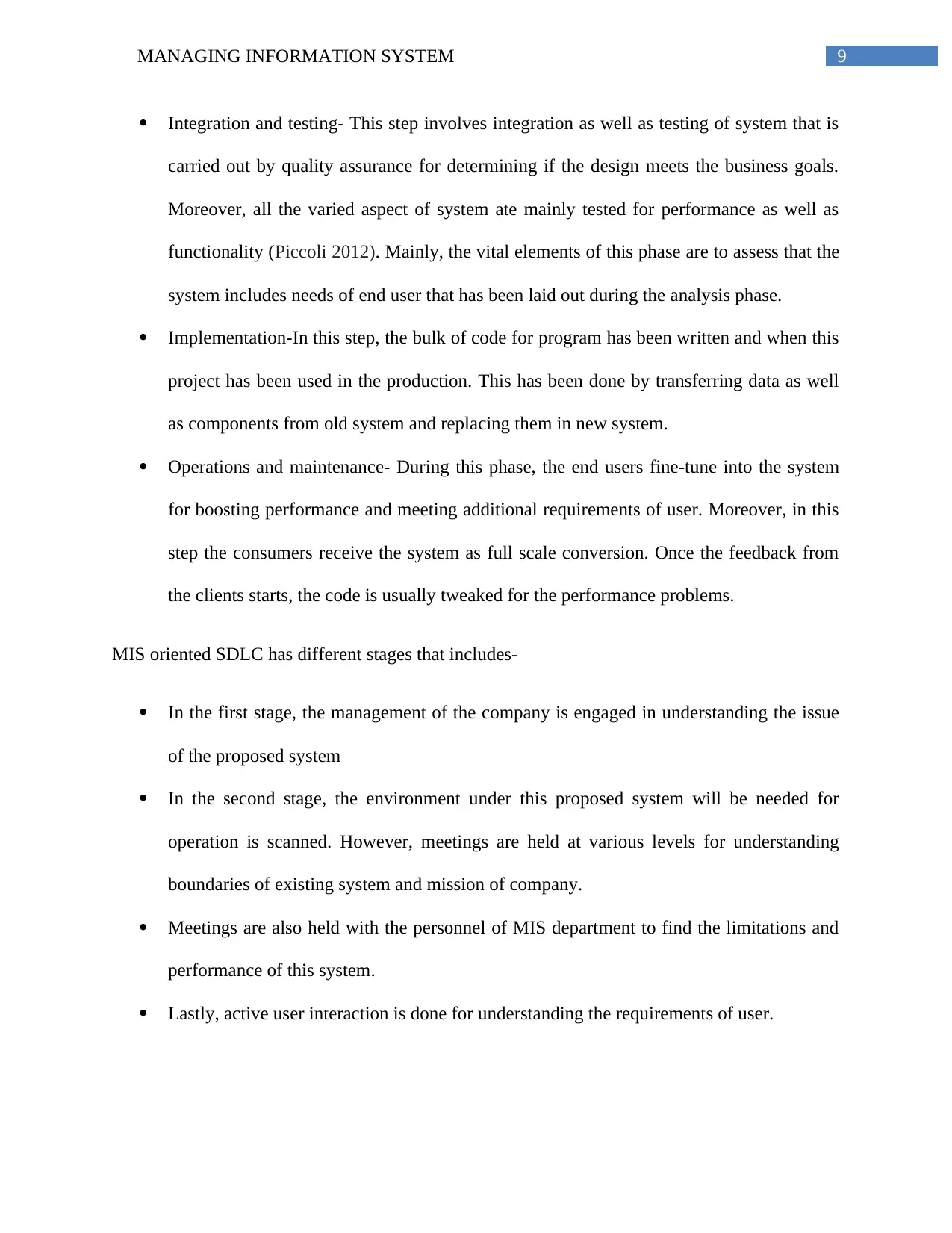
9MANAGING INFORMATION SYSTEM
Integration and testing- This step involves integration as well as testing of system that is
carried out by quality assurance for determining if the design meets the business goals.
Moreover, all the varied aspect of system ate mainly tested for performance as well as
functionality (Piccoli 2012). Mainly, the vital elements of this phase are to assess that the
system includes needs of end user that has been laid out during the analysis phase.
Implementation-In this step, the bulk of code for program has been written and when this
project has been used in the production. This has been done by transferring data as well
as components from old system and replacing them in new system.
Operations and maintenance- During this phase, the end users fine-tune into the system
for boosting performance and meeting additional requirements of user. Moreover, in this
step the consumers receive the system as full scale conversion. Once the feedback from
the clients starts, the code is usually tweaked for the performance problems.
MIS oriented SDLC has different stages that includes-
In the first stage, the management of the company is engaged in understanding the issue
of the proposed system
In the second stage, the environment under this proposed system will be needed for
operation is scanned. However, meetings are held at various levels for understanding
boundaries of existing system and mission of company.
Meetings are also held with the personnel of MIS department to find the limitations and
performance of this system.
Lastly, active user interaction is done for understanding the requirements of user.
Integration and testing- This step involves integration as well as testing of system that is
carried out by quality assurance for determining if the design meets the business goals.
Moreover, all the varied aspect of system ate mainly tested for performance as well as
functionality (Piccoli 2012). Mainly, the vital elements of this phase are to assess that the
system includes needs of end user that has been laid out during the analysis phase.
Implementation-In this step, the bulk of code for program has been written and when this
project has been used in the production. This has been done by transferring data as well
as components from old system and replacing them in new system.
Operations and maintenance- During this phase, the end users fine-tune into the system
for boosting performance and meeting additional requirements of user. Moreover, in this
step the consumers receive the system as full scale conversion. Once the feedback from
the clients starts, the code is usually tweaked for the performance problems.
MIS oriented SDLC has different stages that includes-
In the first stage, the management of the company is engaged in understanding the issue
of the proposed system
In the second stage, the environment under this proposed system will be needed for
operation is scanned. However, meetings are held at various levels for understanding
boundaries of existing system and mission of company.
Meetings are also held with the personnel of MIS department to find the limitations and
performance of this system.
Lastly, active user interaction is done for understanding the requirements of user.
Paraphrase This Document
Need a fresh take? Get an instant paraphrase of this document with our AI Paraphraser
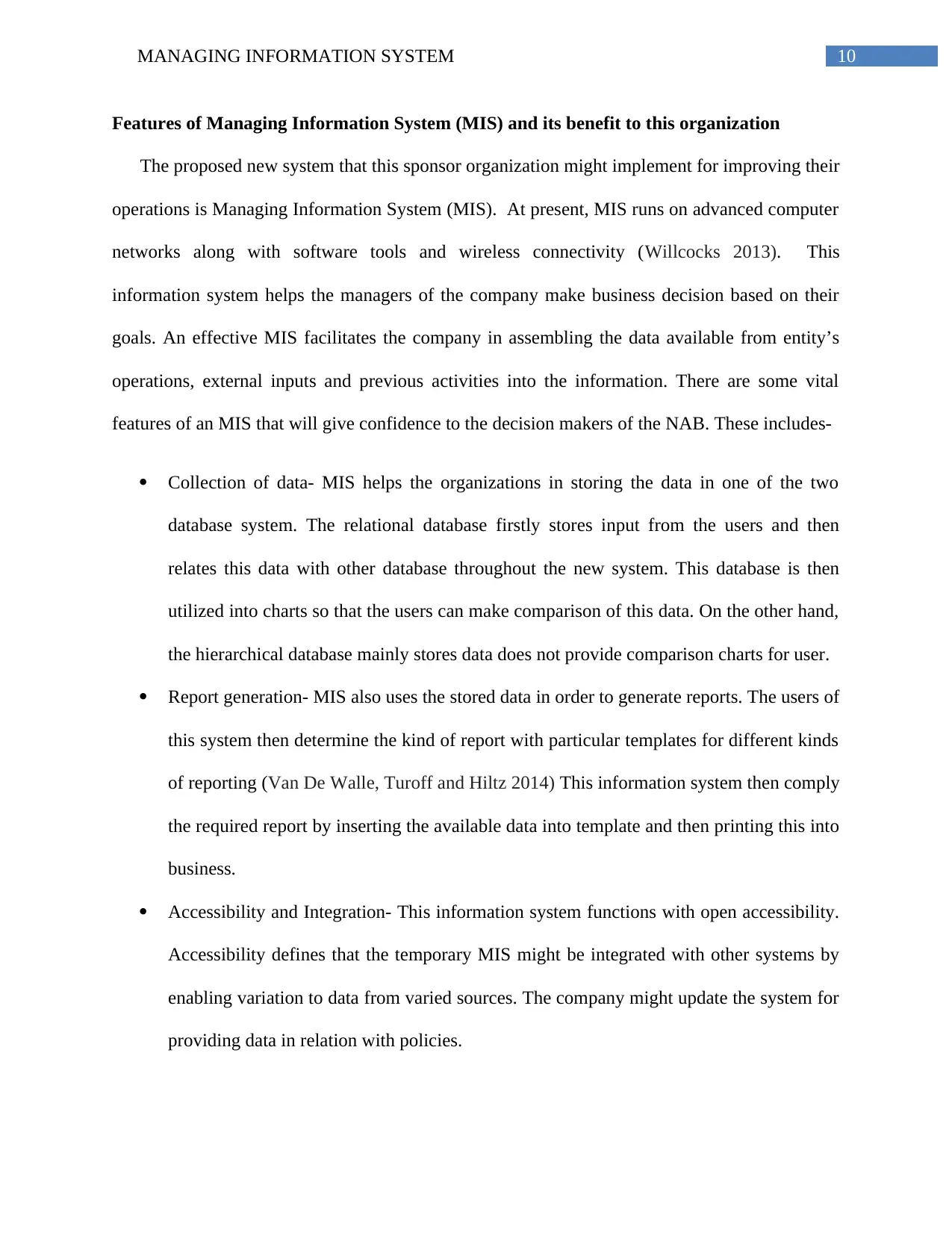
10MANAGING INFORMATION SYSTEM
Features of Managing Information System (MIS) and its benefit to this organization
The proposed new system that this sponsor organization might implement for improving their
operations is Managing Information System (MIS). At present, MIS runs on advanced computer
networks along with software tools and wireless connectivity (Willcocks 2013). This
information system helps the managers of the company make business decision based on their
goals. An effective MIS facilitates the company in assembling the data available from entity’s
operations, external inputs and previous activities into the information. There are some vital
features of an MIS that will give confidence to the decision makers of the NAB. These includes-
Collection of data- MIS helps the organizations in storing the data in one of the two
database system. The relational database firstly stores input from the users and then
relates this data with other database throughout the new system. This database is then
utilized into charts so that the users can make comparison of this data. On the other hand,
the hierarchical database mainly stores data does not provide comparison charts for user.
Report generation- MIS also uses the stored data in order to generate reports. The users of
this system then determine the kind of report with particular templates for different kinds
of reporting (Van De Walle, Turoff and Hiltz 2014) This information system then comply
the required report by inserting the available data into template and then printing this into
business.
Accessibility and Integration- This information system functions with open accessibility.
Accessibility defines that the temporary MIS might be integrated with other systems by
enabling variation to data from varied sources. The company might update the system for
providing data in relation with policies.
Features of Managing Information System (MIS) and its benefit to this organization
The proposed new system that this sponsor organization might implement for improving their
operations is Managing Information System (MIS). At present, MIS runs on advanced computer
networks along with software tools and wireless connectivity (Willcocks 2013). This
information system helps the managers of the company make business decision based on their
goals. An effective MIS facilitates the company in assembling the data available from entity’s
operations, external inputs and previous activities into the information. There are some vital
features of an MIS that will give confidence to the decision makers of the NAB. These includes-
Collection of data- MIS helps the organizations in storing the data in one of the two
database system. The relational database firstly stores input from the users and then
relates this data with other database throughout the new system. This database is then
utilized into charts so that the users can make comparison of this data. On the other hand,
the hierarchical database mainly stores data does not provide comparison charts for user.
Report generation- MIS also uses the stored data in order to generate reports. The users of
this system then determine the kind of report with particular templates for different kinds
of reporting (Van De Walle, Turoff and Hiltz 2014) This information system then comply
the required report by inserting the available data into template and then printing this into
business.
Accessibility and Integration- This information system functions with open accessibility.
Accessibility defines that the temporary MIS might be integrated with other systems by
enabling variation to data from varied sources. The company might update the system for
providing data in relation with policies.
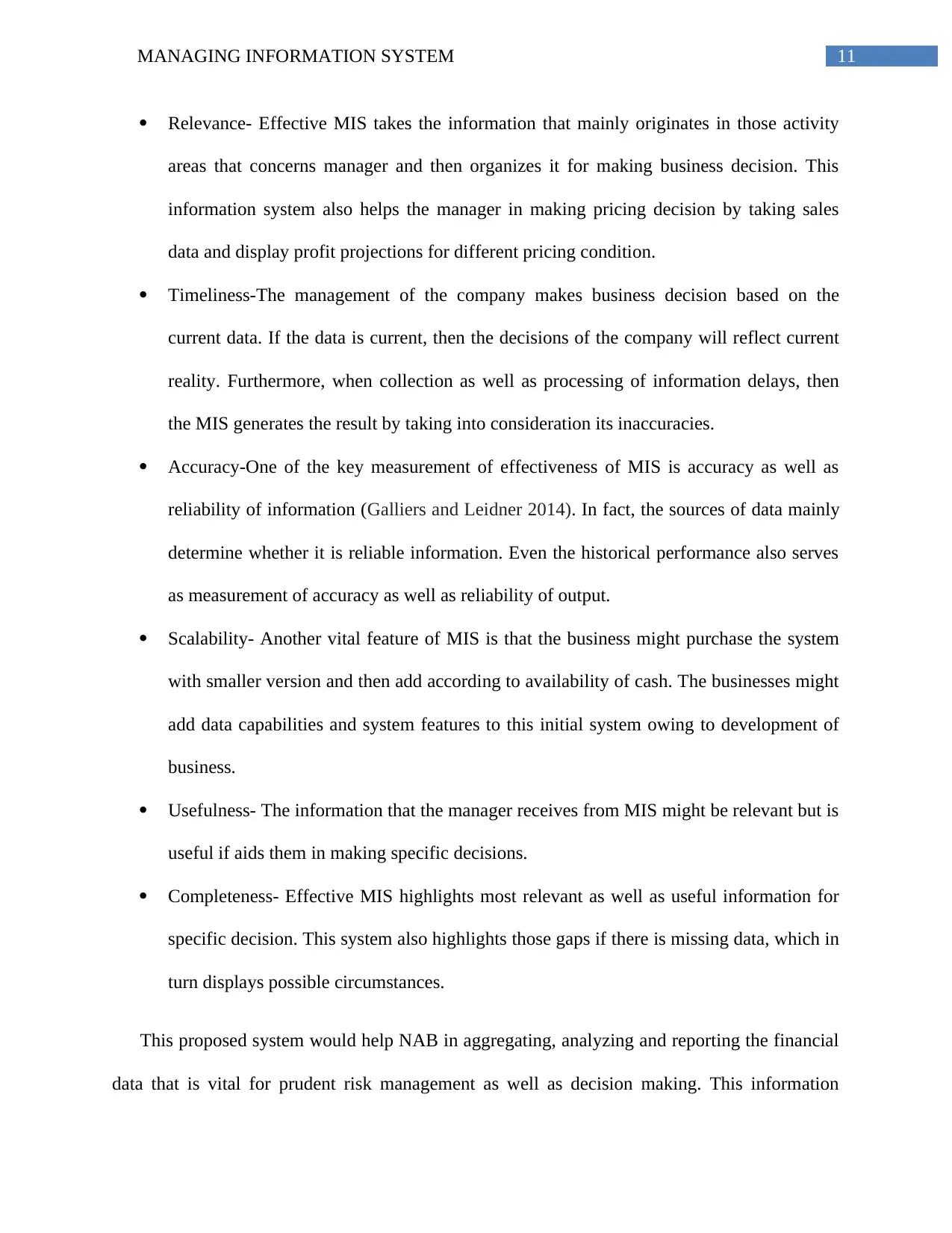
11MANAGING INFORMATION SYSTEM
Relevance- Effective MIS takes the information that mainly originates in those activity
areas that concerns manager and then organizes it for making business decision. This
information system also helps the manager in making pricing decision by taking sales
data and display profit projections for different pricing condition.
Timeliness-The management of the company makes business decision based on the
current data. If the data is current, then the decisions of the company will reflect current
reality. Furthermore, when collection as well as processing of information delays, then
the MIS generates the result by taking into consideration its inaccuracies.
Accuracy-One of the key measurement of effectiveness of MIS is accuracy as well as
reliability of information (Galliers and Leidner 2014). In fact, the sources of data mainly
determine whether it is reliable information. Even the historical performance also serves
as measurement of accuracy as well as reliability of output.
Scalability- Another vital feature of MIS is that the business might purchase the system
with smaller version and then add according to availability of cash. The businesses might
add data capabilities and system features to this initial system owing to development of
business.
Usefulness- The information that the manager receives from MIS might be relevant but is
useful if aids them in making specific decisions.
Completeness- Effective MIS highlights most relevant as well as useful information for
specific decision. This system also highlights those gaps if there is missing data, which in
turn displays possible circumstances.
This proposed system would help NAB in aggregating, analyzing and reporting the financial
data that is vital for prudent risk management as well as decision making. This information
Relevance- Effective MIS takes the information that mainly originates in those activity
areas that concerns manager and then organizes it for making business decision. This
information system also helps the manager in making pricing decision by taking sales
data and display profit projections for different pricing condition.
Timeliness-The management of the company makes business decision based on the
current data. If the data is current, then the decisions of the company will reflect current
reality. Furthermore, when collection as well as processing of information delays, then
the MIS generates the result by taking into consideration its inaccuracies.
Accuracy-One of the key measurement of effectiveness of MIS is accuracy as well as
reliability of information (Galliers and Leidner 2014). In fact, the sources of data mainly
determine whether it is reliable information. Even the historical performance also serves
as measurement of accuracy as well as reliability of output.
Scalability- Another vital feature of MIS is that the business might purchase the system
with smaller version and then add according to availability of cash. The businesses might
add data capabilities and system features to this initial system owing to development of
business.
Usefulness- The information that the manager receives from MIS might be relevant but is
useful if aids them in making specific decisions.
Completeness- Effective MIS highlights most relevant as well as useful information for
specific decision. This system also highlights those gaps if there is missing data, which in
turn displays possible circumstances.
This proposed system would help NAB in aggregating, analyzing and reporting the financial
data that is vital for prudent risk management as well as decision making. This information
⊘ This is a preview!⊘
Do you want full access?
Subscribe today to unlock all pages.

Trusted by 1+ million students worldwide
1 out of 19
Related Documents
Your All-in-One AI-Powered Toolkit for Academic Success.
+13062052269
info@desklib.com
Available 24*7 on WhatsApp / Email
![[object Object]](/_next/static/media/star-bottom.7253800d.svg)
Unlock your academic potential
Copyright © 2020–2025 A2Z Services. All Rights Reserved. Developed and managed by ZUCOL.




